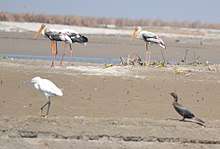Hastinapur Wildlife Sanctuary
Hastinapur Sanctuary was founded in 1986, in Meerut, Muzzafarnagar, Ghaziabad, Bijnor, and Amroha districts of Uttar Pradesh, India. It is a large sanctuary, covering an area of 2073 square kilometers.[1] The population of the wild animals includes various species of animals including antelope, sambhar, cheetal, blue bull, leopard, hyena, wild cat, and different types of birds. It also houses of alligators.

Setting
Hastinapur Wildlife Sanctuary lies on the western bank of the Ganga or Ganges River. The landforms include Khola (elevated alluvial deposition, lying parallel to the river), Khadar (low-lying sandy river bank on either side of the Ganga), and the Boodhi Ganga, a belt of swamps, marshes, channels, and shallow lakes following the old bed of the Ganga, which runs parallel to the Ganga at the western edge of the sanctuary.
The sanctuary is named for the ancient city of Hastinapur, which lies on west bank of the Boodhi Ganga.
17% of the sanctuary is habitat, of which 35.8% is tall wet grasslands, 23.5% is short wet grasslands, 29.4% is dry scrub grasslands, and 11.8% plantations. The remaining 83% is under cultivation or settlements.[2]
Flora and fauna
Hastinapur Wildlife Sanctuary is in the Upper Gangetic plains moist deciduous forests ecoregion.[3]
Plant communities include dry mixed deciduous forests and scrub, dry tropical (Khair-sissoo) riverine forest, and dry grasslands.[4]
Fauna include jungle cat, hyaena, wolf, wild boar, sambhar, chital, jungle fowl, partridge, and ducks.[5] The sanctuary is home to an isolated but viable population of Barasingha, or swamp deer (Rucervus duvaucelii).[6]
The Ganga and Boodhi Ganga are home to the Ganges River Dolphin (Platanista gangetica gangetica), Gharial (Gavialis gangeticus), and Smooth-coated otter (Lutrogale perspicillata).[7]
Location
By Air
The nearest airport is Delhi, which is around 110 km away.
By Rail
Nearest railhead is Meerut, which is 40 km from the sanctuary.
By Road
Hastinapur on National Highway No. 119 Delhi-Meerut-Pauri and is connected by road to all parts of the state.
Attractions
The marshy land along the Ganges makes this sanctuary a haven for migratory birds. Over 350 species of birds are found here such as painted stork, black and white necked stork, sarus crane, as well as night birds of prey, ranging from the great Indian horned owl to the jungle owlet, colourful woodpecker, barbet, kingfisher, minivet, bee-eater and bulbul.
Hastinapur National Park is rich in faunal wealth because of the varied types of ecological niches existing in the reserve. The main groups occur are mammals, birds, reptiles (snakes and lizards), amphibians (frogs & toads) butterflies and fishes, and chiefly the invertebrate groups are, the Scorpions, Centipedes, Odonata (dragon & damselflies), Hymenoptera (wasps, bees, etc.) Isoptera (termites) and Lepidoptera which comprises more than 60 species. Our National Bird Peacock is found here in abundance.
Other inhabitants include the sloth bear, jackal, wild pig and the lesser cats- fishing cat, leopard cat, jungle cat and civet. Hastinapur has also an abundance of birds. There are spectacular painted storks, black and white necked storks, sarus cranes and varied night birds of prey, ranging from the great Indian horned owl to the jungle owlet, Colorful woodpeckers, barbets, kingfishers, minivets, bee eaters and bulbuls flit through the forest canopy.
Gangetic dolphins have been spotted in certain stretches along the river, especially between Haridwar and Bijnor.
Save Sanctuary Movement
The Hastinapur wildlife sanctuary has one third part of total sanctuary area of Uttar Pradesh. 25 years ago it was notified as wildlife sanctuary to protect ecology, biodiversity of Ganga basin and conserve global, national, regional, state and local environment. It is important that steps are taken by the government to develop this area in the same way as they have developed Corbett National Park or the Ranthambore Wildlife Sanctuary and invite investment for development of hotel and other tourism related infrastructure inside the sanctuary area to encourage tourism. This will give lot of employment opportunities to the local population at the same time develop the area for wildlife tourism.
Industrial activities are generating air, water and noise pollution in the sanctuary, stone crushers, sugar mill, organics, paper mill, chemical industries, cotton mill, fiber unit, automobiles, rubber industries, brick bhattas and others polluted units are violating the acts openly. Large numbers are decreasing of wildlife as swamp deer, the Ganges dolphin, skimmer, leopard, crocodile and other IUCN Red Listed species because natural habitat damaged of indigenous species and those hunting.
To make a proper sanctuary, Greenman Vijaypal Baghel an environmental activist is fighting against hunting, illegal encroaching, tree cutting, sand mining, biodiversity destroying, violating of Wildlife Protection Act and other related guidelines since 2001. Paryawaran Sachetak Samiti and WWF have organized many activities to protect Hastinapur Wildlife Sanctuary.
Dr. Ravindra Shukla is an advocate, environmentalist, and animal rights activist, working with Smt. Meneka Sanjay Gandhi's organisation PFA for ten years to protect the sanctuary. He had lodged many FIR against animal smugglers, mining mafias, and wildlife smugglers. He is fighting against corrupt officials.
See also
References
- ↑ Khan, Mohd. "Composition and conservation status of avian species at Hastinapur Wildlife Sanctuary, Uttar Pradesh, India" Journal of Threatened Taxa 26 August 2013. 5(12): 4174-4721
- ↑ Khan, Mohd. "Composition and conservation status of avian species at Hastinapur Wildlife Sanctuary, Uttar Pradesh, India" Journal of Threatened Taxa 26 August 2013. 5(12): 4174-4721
- ↑ "Upper Gangetic Plains Moist Deciduous Forests". World Wildlife Fund. Accessed 22 November 2017
- ↑ Sharad Singh Negi. Handbook of National Parks, Wildlife Sanctuaries, and Biosphere Reserves in India. Indus Publishing, 2002. P. 160.
- ↑ Sharad Singh Negi. Handbook of National Parks, Wildlife Sanctuaries, and Biosphere Reserves in India. Indus Publishing, 2002. P. 160.
- ↑ Khan, M.S. & F. Abbasi (2015). "How the local community views wildlife conservation: a case of Hastinapur Wildlife Sanctuary, Uttar Pradesh, India." Journal of Threatened Taxa 7(2): 6934–6939; https://dx.doi.org/10.11609/JoTT.o3943.6934-9
- ↑ Khan, M.S. & F. Abbasi (2015). "How the local community views wildlife conservation: a case of Hastinapur Wildlife Sanctuary, Uttar Pradesh, India." Journal of Threatened Taxa 7(2): 6934–6939; https://dx.doi.org/10.11609/JoTT.o3943.6934-9